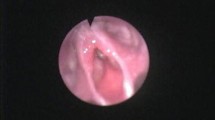Abstract
Many neonates are referred for a diagnosis with stridor. The gold standard investigation has traditionally been a rigid or direct microlaryngoscopy. This impacts on existing theatre schedules, demands a high level of skills from the paediatric anaesthetist along with the risk of exposing a neonate to a general anaesthetic. A bed in paediatric intensive care is often required and must be reserved. As laryngomalacia is the most common diagnosis and less serious than the investigations for infants with stridor themselves, clinicians have been looking to use the flexible fibre-optic laryngoscope to view the upper airway in awake neonatal patients. We present our experience in 66 neonatal patients initially managed by awake per-oral flexible fibre-optic laryngoscopy for stridor. We conclude that the technique is safe, straightforward and allows a diagnosis to be achieved in a significant number of cases. We recommend it as a first line investigation, reserving microlaryngoscopy for the group of patients in whom a diagnosis cannot be made in the outpatient clinic.


Similar content being viewed by others
References
Callum K, Gray A, Hoile R, et al (1999) Extremes of age. 1999 NCEPOD report. National Confidential Enquiry into Perioperative Deaths, London
Botma M, Kishore A, Kubba H, Geddes N (2000) The role of fibre optic laryngoscopy in infants with stridor. Int J Pediatr Otorhinolaryngol 55:17–20
Olney D, Greinwald J, Smith R, Bauman N (1999) Laryngomalacia and its treatment. Laryngoscope 109:1770–1775
Gagliano J, Jafek B (2001) In: Jafek B, Marrow B (eds). ENT secrets. Hanley & Belfus 67, Philadelphia, pp 429–436
Thurmond M, Cole D (1996) Stridor in the neonate: laryngomalacia. J Louisiana State Med Soc 148:375–378
Silberman HD, Wilf H, Tucker J (1976) Flexible fibreoptic nasopharyngolaryngoscope. Ann Otol Rhinol Laryngol 85:640–645
Hinton A, O’Connell J, van Besouw J, Wyatt M (1997) Neonatal and pediatric fiber-optic laryngoscopy using the laryngeal mask airway. J Laryngol Otol 111:349–353
Mancuso R, Choi, S, Zalzal G, Grundfast K (1996) Laryngomalacia. The search for the second lesion. Arch Otolaryngol Head Neck Surg 122:302–306
Bluestone C, Healey G, Cotton R (1996) Diagnosis of larygomalacia is not enough! Arch Otolaryngol Head Neck Surg 122:1417
Filoppone M, Narne S, Pettenazzo A, Zachello F, Barldi E (2000) Functional approach to infants and young children with noisy breathing: validation of pneumotachography by blinded comparison with bronchoscopy. Am J Respir Crit Care Med 162:1795–1800
Waters K, Woo P, Mortelliti A, Colton R (1996) Assessment of the infant airway with videorecorded flexible laryngoscopy and the objective analysis of vocal fold abduction. Otolaryngol Head Neck Surg 114:554–561
Hawkins D, Clark R (1987) Flexible laryngoscopy in neonates and young children. Ann Otol Rhinol Laryngol 96:81–85
Berkowitz R (1998) Neonatal upper airway assessment by awake flexible laryngoscopy. Ann Otol Rhinol Laryngol 107:75–80
Department of Health Services Directorate. National Coordinating Group on Paediatric Intensive Care (1997) Report to the NHS Executive. Paediatric Intensive Care “A Framework for the Future”, July
Kayaykar R, Gray R (2001) Per oral awake flexible fibre-optic laryngoscopy in the investigation of children with stridor without respiratory distress. J Laryngol Otol 115:894–896
Author information
Authors and Affiliations
Corresponding author
Rights and permissions
About this article
Cite this article
Moumoulidis, I., Gray, R.F. & Wilson, T. Outpatient fibre-optic laryngoscopy for stridor in children and infants. Eur Arch Otorhinolaryngol 262, 204–207 (2005). https://doi.org/10.1007/s00405-004-0804-2
Received:
Accepted:
Published:
Issue Date:
DOI: https://doi.org/10.1007/s00405-004-0804-2




